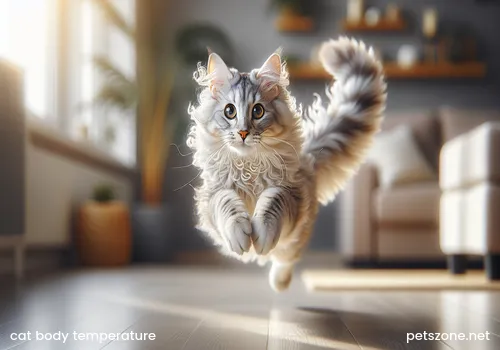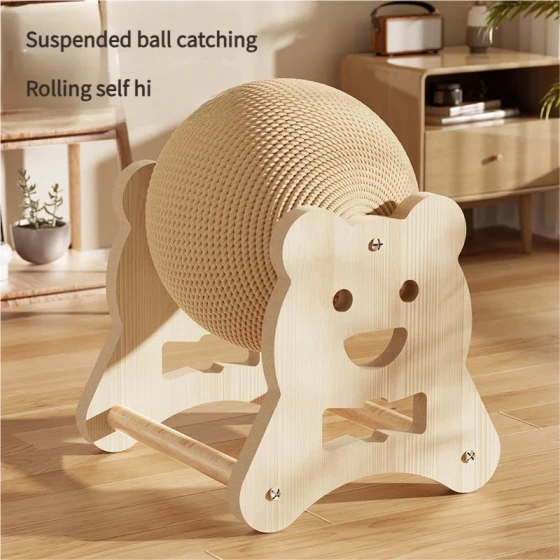Cat's Normal Body Temperature_How to Identify and Handle Cat Fever Symptoms
A cat's normal body temperature is usually slightly higher than that of humans, generally between 38.1°C and 39.2°C. If a cat's temperature exceeds this normal range, especially if it remains high, it may mean the cat has a fever. This is a warning signal from the body indicating some illness or infection, requiring the owner's attention and timely assessment to determine if professional veterinary help is needed.

What is a Cat's Normal Body Temperature?
Unlike the commonly considered human normal temperature of around 37°C, a healthy adult cat's temperature ranges from 38.1°C to 39.2°C. Kittens might have slightly higher temperatures, but the difference is not significant. This temperature range is necessary for the proper functioning of the cat’s physiological processes. Understanding this normal range is the first step in determining if a cat has a fever.
Why is Monitoring Cat Temperature Important?
Body temperature is one of the key indicators reflecting an animal's health. A raised body temperature (fever) usually means the cat’s body is fighting bacteria, viruses, or other pathogens, or there is inflammation inside. Persistent high fever can consume a cat’s energy, potentially harming organ function and even threatening its life. Therefore, timely detection and management of a cat’s fever are crucial to protecting its health.
How to Measure a Cat’s Temperature?
There are several methods to measure a cat's temperature, each with different levels of accuracy:
- Rectal Measurement (Most Accurate): Currently recognized as the most accurate method to measure a cat's temperature. Use a pet-specific thermometer, apply a small amount of petroleum jelly or baby oil as lubricant, then gently insert it about 1-2 centimeters into the cat's rectum. Handle carefully to avoid hurting the cat, and it’s best to have someone assist to hold the cat, reducing their stress and resistance. Digital thermometers usually display results within seconds to a minute.
- Ear Temperature Measurement: Use a pet-specific ear thermometer to measure the temperature inside the cat’s ear. This method is less stressful for the cat and easier to perform. However, it requires the thermometer to be placed correctly deep in the ear canal, which should be free of dirt or ear mites to ensure measurement accuracy.
- Non-contact Measurement: Some non-contact infrared thermometers can measure the surface temperature of a cat’s skin, like the forehead or outer ear. However, this method only measures surface temperature and is greatly influenced by environmental temperature and the cat’s fur, so it cannot accurately reflect core body temperature. It can be used for preliminary screening but not for fever diagnosis.
- Judging by Touch: Judging a cat's temperature by touching its ear, nose, or belly is inaccurate. While these areas might feel warmer during fever, this perception is influenced by many factors, such as just waking up or sunbathing, and lacks scientific basis. Do not rely solely on touch to determine if a cat has a fever.
What Are the Signs of Cat Fever?
When a cat has a fever, besides elevated temperature, it usually shows noticeable behavioral and physiological changes that attentive owners can easily detect:
- Lethargy and loss of appetite: A usually lively and active cat suddenly becomes sluggish, loses interest in playing, and spends most of the time sleeping or hiding. Food intake significantly decreases, sometimes refusing to eat or drink altogether.
- Hiding: Sick cats often seek a quiet, secluded place to be alone.
- Feeling hot to touch: As mentioned before, though inaccurate, many owners notice the cat’s ears, nose (normally moist and cool), or groin area feels warmer than usual.
- Shivering or chills: Cats might shiver due to abnormal body temperature regulation.
- Increased breathing or heart rate: Fever raises metabolism, causing faster breathing and heartbeat.
- Ungroomed fur: Sick cats often lack the energy to groom themselves, making their fur appear messy.
- Vomiting or diarrhea: Some illnesses that cause fever might also bring on digestive symptoms.
What to Do If Your Cat Has a Fever?
Once it is confirmed through accurate measurement (preferably rectal or ear) that the cat’s temperature exceeds the normal range, it likely has a fever. At this point, the owner should stay calm and take the following steps:
- Do not give human medication: Never give your cat human fever-reducing medicines (such as acetaminophen, ibuprofen, etc.). These drugs are highly toxic to cats and may cause severe liver damage or even death.
- Provide plenty of water: Fever can lead to dehydration, so ensure fresh and clean water is available. If the cat refuses to drink, water can be administered in small amounts with a syringe or dropper.
- Physical cooling (use with caution): You can gently wipe the ear tips, paw pads, and groin areas with warm water (note: warm water, not cold or ice water) to help heat dissipation. Observe the cat's reaction carefully; if the cat strongly resists, do not force it to avoid increasing stress. Excessive or rapid cooling may cause hypothermia, which is counterproductive.
- Seek veterinary care promptly: Fever is a symptom, not a disease itself. The key is to find and treat the underlying cause of the fever. Therefore, it is strongly recommended to take the cat to a vet as soon as fever is detected. The vet can diagnose the cause (which may be infection, inflammation, stress, or other diseases) and provide professional treatment.
When Should You Seek Emergency Veterinary Care?
In some cases, a cat’s fever is an urgent matter requiring immediate veterinary attention:
- Body temperature is very high (e.g., above 40°C).
- Fever is accompanied by other severe symptoms such as difficulty breathing, continuous vomiting or diarrhea, seizures, or weakness to the point of being unable to stand.
- Fever in kittens, elderly cats, or cats with chronic illnesses.
- Symptoms do not improve or worsen after initial observation and care.
Frequently Asked Questions
- Q: My cat’s nose is dry. Does that mean it has a fever?
A: Not necessarily. The moisture of a cat’s nose is influenced by many factors, such as environmental humidity or just waking up. Although a feverish cat’s nose may be dry and warm, this is not an accurate indicator of fever. Accurate temperature measurement is key. - Q: Can I tell if my cat has a fever by feeling its ear?
A: This method is inaccurate. The temperature felt by touching the ear is affected by many factors and is not as precise as thermometer measurement. - Q: Can cat fever be transmitted to humans?
A: Generally, a cat's fever itself is not contagious to humans. The pathogens causing the fever (like certain viruses or bacteria) are usually species-specific. However, some pathogens can be transmitted between animals and humans (zoonoses), so maintaining good hygiene is always advisable.
Summary
Knowing the normal temperature range of cats, mastering proper temperature measurement methods, and being alert to signs of fever are essential knowledge for every responsible cat owner. Fever is the cat’s body sending a distress signal. While mild fevers might be transient, persistent or accompanied by severe symptoms often indicate the need for professional medical intervention. When a cat is found to have a fever, never medicate it yourself. Seek veterinary help promptly to ensure your cat recovers quickly and continues to happily accompany you.





